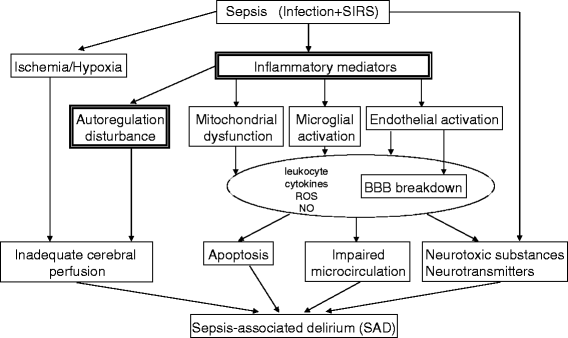A clinical perspective of sepsis-associated delirium
- PMID: 27011789
- PMCID: PMC4804610
- DOI: 10.1186/s40560-016-0145-4
A clinical perspective of sepsis-associated delirium
Abstract
The term sepsis-associated encephalopathy (SAE) has been applied to animal models, postmortem studies in patients, and severe cases of sepsis. SAE is considered to include all types of brain dysfunction, including delirium, coma, seizure, and focal neurological signs. Clinical data for sepsis-associated delirium (SAD) have been accumulating since the establishment of definitions of coma or delirium and the introduction of validated screening tools. Some preliminary studies have examined the etiology of SAD. Neuroinflammation, abnormal cerebral perfusion, and neurotransmitter imbalances are the main mechanisms underlying the development of SAD. However, there are still no specific diagnostic blood, electrophysiological, or imaging tests or treatments specific for SAD. The duration of delirium in intensive care patients is associated with long-term functional disability and cognitive impairment, although this syndrome usually reverses after the successful treatment of sepsis. Once the respiratory and hemodynamic states are stabilized, patients with severe sepsis or septic shock should receive rehabilitation as soon as possible because early initiation of rehabilitation can reduce the duration of delirium. We expect to see further pathophysiological data and the development of novel treatments for SAD now that reliable and consistent definitions of SAD have been established.
Keywords: Acute brain dysfunction; Coma; Confusion Assessment Method for the Intensive Care Unit (CAM-ICU); Delirium; Intensive Care Delirium Screening Checklist (ICDSC); Sepsis-associated encephalopathy (SAE).
Figures




References
-
- Levy MM, Fink MP, Marshall JC, Abraham E, Angus D, Cook D, Cohen J, Opal SM, Vincent J-L, Ramsay G, For the International Sepsis Definitions Conference SCCM/ESICM/ACCP/ATS/SIS International Sepsis Definitions Conference. Crit Care Med. 2001;2003(31):1250–6. - PubMed
Publication types
LinkOut - more resources
Full Text Sources
Other Literature Sources

